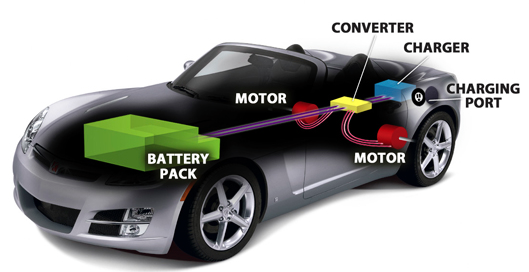How do Electric Vehicles Work?
Electric Vehicles are able to run solely on electric power, independent of all other fuel sources. Other similar vehicles such as the PHEV are able to run on electric power for a short period of time, however they contain an internal combustion engine that allows them to run on fuel once their battery dies. For this reason, an EV battery is often much larger and more capable than that of its PHEV counterpart. Figure 1 below shows a diagram of an EV car, with its major components labeled.

The process is fairly simple. The battery is charged via the charging port in the back of the diagram (See the Pros & Cons section for more information about various charging types). The battery then supplies energy to the converter, which converts the electrical energy into mechanical energy. The converter is coupled with the motor which provides rotational power at the wheels. Most cars have another feature in which the braking mechanism on the wheels works to transfer energy to the motor where it essentially functions as a generator. This energy is stored back into the battery until it is need again to accelerate the vehicle. This feature allows energy that would normally be lost in braking or coasting to be conserved.
Below is a video provided which explains further how these vehicles operate, and also how they differ from their plug-in hybrid counterparts.
For more information on the advantages and disadvantages of selecting a fully electric vehicle versus a plug in hybrid or conventional gasoline vehicle, check out the Pro & Cons section of the site.
For a comprehensive fact sheet concerning EV vehicles, click here.
References:
http://www.ucsusa.org/clean-vehicles/electric-vehicles/how-do-battery-electric-cars-work#.VUp_CtVT629
https://www.fueleconomy.gov/feg/phevtech.shtml